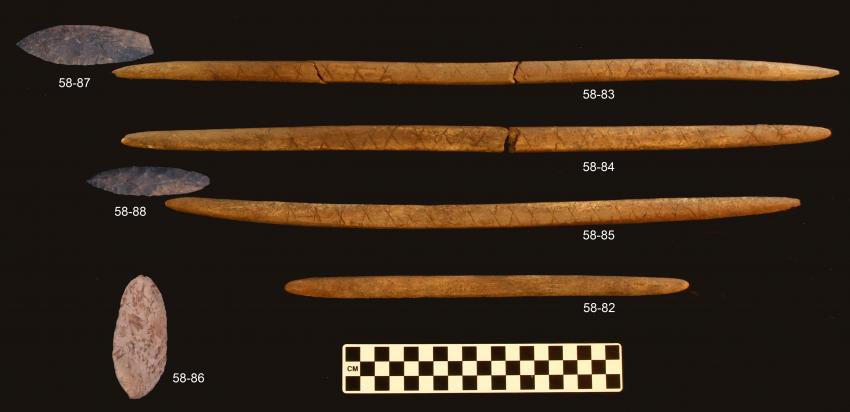Announcement
Collapse
No announcement yet.
Alaskan Infant Burials
Collapse
X
-
Another super interesting find! I wonder do those look like Agate Basin
Style points? I also found it interesting that the infants were all born in the summer month's. .. considering the massive hardships these people's endured, you reckon they were inclined to plan there pregnancies to occur in the most optimal and favorable conditions? Makes sense to me!
Josh (Ky/Tn collector)
-
Check it out, Josh.....Kyflintguy wrote:
Another super interesting find! I wonder do those look like Agate Basin
Style points? I also found it interesting that the infants were all born in the summer month's. .. considering the massive hardships these people's endured, you reckon they were inclined to plan there pregnancies to occur in the most optimal and favorable conditions? Makes sense to me!
Rhode Island
Comment
-
Here are links to the paper and supplemental info:
New insights into Eastern Beringian mortuary behavior: A terminal Pleistocene double infant burial at Upward Sun River
Here we report on the discovery of two infant burials dating to
11,500 calibrated years (cal) B.P. at the Upward Sun River site in
central Alaska. The infants were interred in a pit feature with
associated organic and lithic grave goods, including the earliest
known North American hafted bifaces with decorated antler foreshafts.
Skeletal and dental analyses indicate that Individual 1 died
shortly after birth and Individual 2 was a late-term fetus, making
these the youngest-aged late Pleistocene individuals known for
the Americas and the only known prenate, offering, to our knowledge,
the first opportunity to explore mortuary treatment of the
youngest members of a terminal Pleistocene North American population.
This burial was situated 40 cm directly below a cremated
3-y-old child previously discovered in association with a central
hearth of a residential feature. The burial and cremation are contemporaneous,
and differences in body orientation, treatment,
and associated grave goods within a single feature and evidence
for residential occupation between burial episodes indicate novel
mortuary behaviors. The human remains, grave goods, and associated
fauna provide rare direct data on organic technology, economy,
seasonality of residential occupations, and infant/child mortality of
terminal Pleistocene Beringians.
More Info: Ben A. Pottera,1, Joel D. Irishb, Joshua D. Reuthera,c, and Holly J. McKinneya
Publication Date: Oct 9, 2014
Publication Name: PNAS
 Here we report on the discovery of two infant burials dating to 11,500 calibrated years (cal) B.P. at the Upward Sun River site in central Alaska. The infants were interred in a pit feature with associated organic and lithic grave goods, including
Here we report on the discovery of two infant burials dating to 11,500 calibrated years (cal) B.P. at the Upward Sun River site in central Alaska. The infants were interred in a pit feature with associated organic and lithic grave goods, including
 Materials and Methods Human Remains Materials and Methods Following a skeletal inventory, osteometric measurements were taken of all complete and refitted elements. The approximate ages of Individuals 1 and 2, along with length and weight of the
Materials and Methods Human Remains Materials and Methods Following a skeletal inventory, osteometric measurements were taken of all complete and refitted elements. The approximate ages of Individuals 1 and 2, along with length and weight of the
\"For you were made from dust, and to dust you will return.\"
Comment
-
i would think so. after a few deaths in the family i would assume its just alot easier having a new born when its "warmer" per say, then in the dead of winter. and it makes sense as well considering animals natural breeding cycle. no doubt they understood when the animals were breeding and when they were giving birth. but,like humans even today, they probably still did what they wanted,when they wanted,lol. but winter months meant more time stuck in the shelter and longer nights, and we all know what that means! :laugh: still one of the best ways to stay warm too.Kyflintguy wrote:
Another super interesting find! I wonder do those look like Agate Basin
Style points? I also found it interesting that the infants were all born in the summer month's. .. considering the massive hardships these people's endured, you reckon they were inclined to plan there pregnancies to occur in the most optimal and favorable conditions? Makes sense to me!
call me Jay, i live in R.I.
Comment
-
I would imagine pregnancy had a lot to do with nutrition. Much less likely to become pregnant if you are in a state of malnutrition.Kyflintguy wrote:
Another super interesting find! I wonder do those look like Agate Basin
Style points? I also found it interesting that the infants were all born in the summer month's. .. considering the massive hardships these people's endured, you reckon they were inclined to plan there pregnancies to occur in the most optimal and favorable conditions? Makes sense to me!
And like others have stated long nights its cold the other kids are asleep
Comment
-
I agree with all said, I just wonder if this circumstance could be taken even further... And this just shows how I can over think something but it makes me wonder if they could have taken childbirth very seriously and perhaps practiced abstinence in the spring to avoid a mid winter birth, Wich I could imagine being extremely risky and taxing on everyone.
Maybe just over thinking that, but it's amazing how having a child makes you look at things a little bit differently as two years ago such a thought may have never crossed my mind .... :rolf:
Josh (Ky/Tn collector)
Comment
-
Looking at it objectively I bet infant mortality was probably a normal fact of life. I find it far more likely that the vast majority of infants born in unfavorable times didnt make it. Practicing abstinence is not normal human behavior, however Im pretty sure there is some sort of Paleo birth control herb around.
Comment


Comment